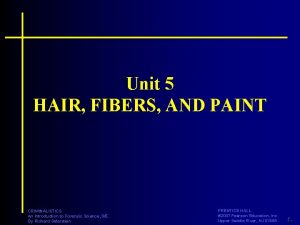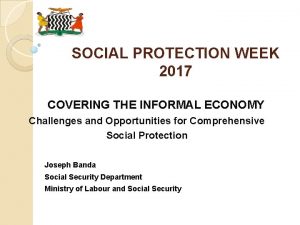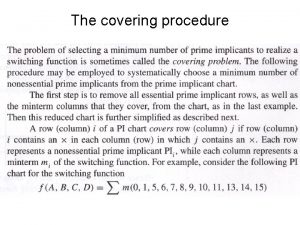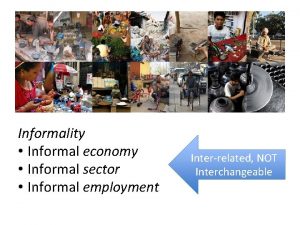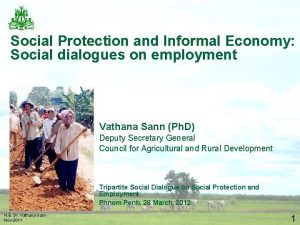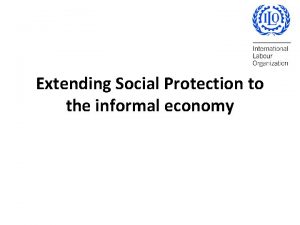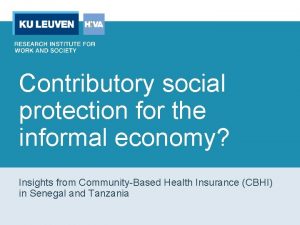SOCIAL PROTECTION WEEK 2017 COVERING THE INFORMAL ECONOMY












- Slides: 12

SOCIAL PROTECTION WEEK 2017 COVERING THE INFORMAL ECONOMY Challenges and Opportunities for Comprehensive Social Protection Joseph Banda Social Security Department Ministry of Labour and Social Security

TABLE OF CONTENT ü ü ü Defination Context Characteristics of Informal Economy Challenges of Extending SP to the Informal Economy Opportunities of Extending SP to the Informal Economy Conclusion

Defination Informal Sector: Refers to all production units that are not registered with a tax or a licensing authority. Informal Employment: Is the type of employment characterized by lack of an entitlement to annual paid leave and absence of social security. This type of employment could be found in both the formal sector and informal sector production units.

Context % of Informal Employment in Total Employment s) TOTAL Percentage Male Percentage Female Percentage Total Population 14, 983, 315 100% 7, 351, 247 49. 06% 7, 632, 068 50. 94 Total Labour 6, 329, 076 Force 100% 3, 045, 159 48. 11% 3, 283, 917 51. 89 Total 5, 859, 225 Employment 100% 2, 789, 012 47. 6% 3, 070, 213 52. 4 629, 626 10. 7% 463, 385 16. 6% 166, 241 5. 4% Informal Economy 5, 229, 599 89. 30% 2, 325, 627 83. 4% 2, 903, 975 94. 6% Total Youth in 3, 090, 782 Informal Employment 59. 10% 1, 323, 244 42. 81% 1, 767, 538 57. 19% Formal Economy Source: LFS, 2014

Context % of New Jobs that are created by the Informal Economy 2005 Total Employed Population 4, 131, 531. 00 New Jobs Created Total Informal Sector Employment 3, 635, 747. 00 2008 2012 2014 4, 606, 846 5, 499, 673 5, 859, 225 475, 315. 00 892, 827 359, 552 4, 095, 508 4, 652, 253 4, 914, 969 556, 745 262, 716 62. 36% 73. 07% New Informal Jobs Created % of new Jobs Created by Informal economy 459, 761. 00 96. 73 % Source: LFS, 2005, 2008, 2012 &2014 5

Context Growth of the Informal Economy 6

Context Informal Economy in GDP in SADC Source: Presentation by. Jürgen Schwettmann, ILO Consultant, November 2017

Characteristics of the Informal Economy Ø small or undefined work places; Ø Inadequate and irregular incomes and in some cases Non-payment of wages; Ø Lack of social security awareness, as a result no coverage; Ø Low levels of skills and productivity; Ø lack of access to information, markets, finance, training and technology Ø High job insecurity coupled with low awareness, representation and demand for workers’ rights; Ø Lack of formal contracts, employment relationships based on oral contracts; Ø informal economy are not recognized, registered, regulated or protected under labour legislation; Ø High occupational accidents due to low occupational safety and health standards Ø unsafe and unhealthy working conditions and long working hours. 8

Challenges of Extending SP to the Informal Economy Ø Lack of a clear legal and policy framework to facilitate transition to formality Ø Lack of sound data base on the informal economy which negatively impacts formulation of the strategy and design of relevant interventions; Fragmentation of agencies conducting programmes that have an impact on formalisation of the informal economy; Lack of organization of Workers in the informal economy; Formal social dialogue mechanisms and institutions excludes the informal economy (TCLC, SS Boards etc) Economic growth – inadequate formal job/GDP growth encourages formalization High cost of entry, (regulatory burden, tax burden) Ø Ø Ø 9

Opportunities for Extending SP to the Informal Economy Ø Political Will and commitment to extend coverage (policy makers and Stakeholders) Ø Draft Social Protection Bill has provisions that will facilitate formalization; Ø Amendment to employment Act – extension of the defination of an employee to include independent contract etc, SI on vulnerable workers; Ø Existance of organisations representing the workers in the informal economy; Ø Trade unions are opening up to the informal economy, and government is recognizing informal economy organnizations; Ø Creation of BRRA – to improve the regulatory environment and lessen the regulatory burden through regulating licensing, issuance of permits, authorisations, or levies, charges and fees payable to start or operate a business; Ø Multi stakeholder TWG on SP Extension 10

CONCLUSION Ø Ø Ø Effective regulatory framework, good governance, better government services, improved business environment, and improving access to financing, technology and infrastructure are essential in developing and formalising informal sector; There is a need to have a sound data base on the informal economy that can be used to formulate a national strategy and design of relevant interventions. There is need to create an integrated approach to the formalisation of the informal economy. Consideration should be made to ensure formalization of both employment (decent work) and enterprises; We need to identify the drivers on informality; 11

The END THANK YOU
 Athens and sparta were both
Athens and sparta were both Child protection reform amendment act 2017
Child protection reform amendment act 2017 Week by week plans for documenting children's development
Week by week plans for documenting children's development Lenguaje culto formal
Lenguaje culto formal Social thinking and social influence in psychology
Social thinking and social influence in psychology Social thinking social influence social relations
Social thinking social influence social relations Cigna vitamin d policy
Cigna vitamin d policy Cigna vitamin d policy
Cigna vitamin d policy Hair under microscope
Hair under microscope Heart membranes
Heart membranes Foil algorithm in machine learning
Foil algorithm in machine learning Medulla hair
Medulla hair Order of formal letter
Order of formal letter








